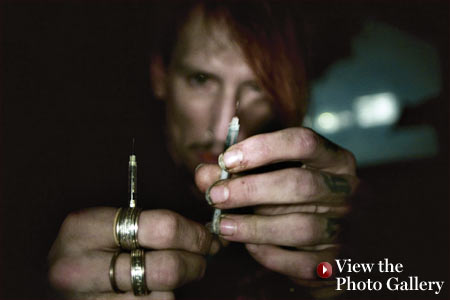The shades were always drawn on the ninth-floor apartment at 4 West 22nd Street. “Shhh,” Mike whispered from his dingy mattress as the sun rose one morning. “If you close your eyes, you can pretend it’s not happening.” Morning was a time for “getting straight,” which actually meant getting high for the rotating cast of a dozen addicts who hid out in this unlikeliest of heroin dens.

For years, a 2,000-square-foot, rent-stabilized apartment steps away from the Flatiron Building provided refuge to a family of sorts. Neither the stately façade nor the prime address offered a hint of what went on inside: “Tricks, smoking crack, snorting dope, shooting dope, hustling—it was a 24/7 party,” recalls Jesse, a pretty 32-year-old who lived there for two years. “You couldn’t close your eyes for a second. Every moment was survival, despite whoever or whatever you had to walk over.”
Old Joe had held the lease since 1973 but slept on the couch after his housemates took his bedroom. Everyone thought he came from money, and when times were good he grew zucchini and tomatoes on the roof and was happily surrounded by young gay men. Things went south for him four years ago, when one of them—his boyfriend—jumped out of the apartment window. Soon Joe was doing as much heroin as others would give him and letting just about anyone stay for free if they’d help him shoot up, since he couldn’t do it himself anymore.
Sometimes that was Jesse, who was grateful for Joe’s hospitality after a decade of street life. She and her boyfriend Mike heard about the place from other users, but her journey there began in high school. Jesse had been home-schooled on a boat by hippie parents, and when they docked in Northport, New York, to take care of an ailing relative, her new life was a shock. “I didn’t know what Guess jeans were,” she recalls. “I didn’t know what cheerleaders were.” Drugs gave her an identity.
At Joe’s place, she shared a bedroom with Mike, the singer for the punk band Murder Junkies, who grew up in middle-class Mount Vernon, New York. His younger brother Joey, who first shot up at 13, lived at old Joe’s place, too.
At first, Jesse and Mike tried to clean up the apartment, and Jesse worked in an antique store to help pay the bills. Soon she lost her job. When nobody paid Con Ed, they turned to candles or electricity stolen from the emergency stairwell. Joey got mad and punched holes in the drywall, next to a tacked-up picture of his 8-year-old daughter. Needles were everywhere.
“It felt like perpetual night—but not in that soothing, bedtime way,” says Jessica Dimmock, a 27-year-old graduate of the International Center of Photography who spent eight months shooting these pictures. “It doesn’t ever feel like it settles into stillness there.”
In June, a year after Joe stopped paying his $1,200-a-month rent, the owners kicked everyone out. Old Joe wound up in a hospital somewhere, and young Joey was last seen on the Lower East Side. Over Labor Day weekend, Jesse’s friend Sean died after drinking a bottle of methadone. Mike’s in jail, and Jesse now spends days in Union Square and nights sleeping on church steps. Compared with her concrete bed, Joe’s hellhole now seems like the Waldorf. “As crazy as it was, I was also part of something,” she says. “But it really got out of control.”
See also
Good Girls at Heroin U